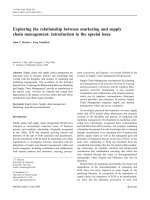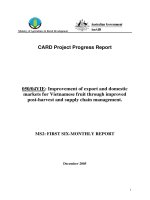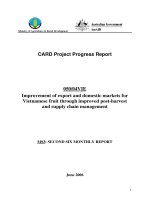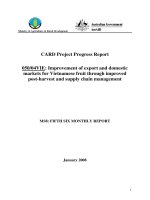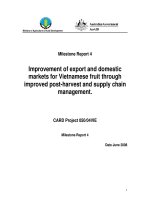The F100 Engine Purchasing And Supply Chain Management Demonstration pdf
Bạn đang xem bản rút gọn của tài liệu. Xem và tải ngay bản đầy đủ của tài liệu tại đây (388.3 KB, 90 trang )
This document and trademark(s) contained herein are protected by law
as indicated in a notice appearing later in this work. This electronic
representation of RAND intellectual property is provided for non-
commercial use only. Permission is required from RAND to reproduce, or
reuse in another form, any of our research documents.
Limited Electronic Distribution Rights
Visit RAND at www.rand.org
Explore RAND Project AIR FORCE
View document details
For More Information
This PDF document was made available
from www.rand.org as a public service of
the RAND Corporation.
6
Jump down to document
THE ARTS
CHILD POLICY
CIVIL JUSTICE
EDUCATION
ENERGY AND ENVIRONMENT
HEALTH AND HEALTH CARE
INTERNATIONAL AFFAIRS
NATIONAL SECURITY
POPULATION AND AGING
PUBLIC SAFETY
SCIENCE AND TECHNOLOGY
SUBSTANCE ABUSE
TERRORISM AND
HOMELAND SECURITY
TRANSPORTATION AND
INFRASTRUCTURE
WORKFORCE AND WORKPLACE
The RAND Corporation is a nonprofit
research organization providing
objective analysis and effective
solutions that address the challenges
facing the public and private sectors
around the world.
Purchase this document
Browse Books & Publications
Make a charitable contribution
Support RAND
This product is part of the RAND Corporation monograph series.
RAND monographs present major research findings that address the
challenges facing the public and private sectors. All RAND mono-
graphs undergo rigorous peer review to ensure high standards for
research quality and objectivity.
Mary E. Chenoweth, Clifford A. Grammich
Prepared for the United States Air Force
Approved for public release, distribution unlimited
The F100 Engine
Purchasing and Supply
Chain Management
Demonstration
Findings from Air Force Spend Analyses
The RAND Corporation is a nonprofit research organization providing
objective analysis and effective solutions that address the challenges
facing the public and private sectors around the world. RAND’s
publications do not necessarily reflect the opinions of its research clients
and sponsors.
R
®
is a registered trademark.
© Copyright 2006 RAND Corporation
All rights reserved. No part of this book may be reproduced in any
form by any electronic or mechanical means (including photocopying,
recording, or information storage and retrieval) without permission in
writing from RAND.
Published 2006 by the RAND Corporation
1776 Main Street, P.O. Box 2138, Santa Monica, CA 90407-2138
1200 South Hayes Street, Arlington, VA 22202-5050
4570 Fifth Avenue, Suite 600, Pittsburgh, PA 15213-2665
RAND URL: />To order RAND documents or to obtain additional information, contact
Distribution Services: Telephone: (310) 451-7002;
Fax: (310) 451-6915; Email:
Cover photo: U.S. Air Force photo by Staff Sgt. Robert Zoellner
The research reported here was sponsored by the United States Air
Force under Contract F49642-01-C-0003. Further information may be
obtained from the Strategic Planning Division, Directorate of Plans, Hq
USAF.
Library of Congress Cataloging-in-Publication Data
Chenoweth, Mary E.
The F100 engine purchasing and supply chain management demonstration :
findings from Air Force spend analyses / Mary E. Chenoweth,
Clifford A. Grammich.
p. cm.
“MG-424.”
Includes bibliographical references.
ISBN 0-8330-3889-3 (pbk. : alk. paper)
1. United States. Air Force—Procurement—Evaluation. 2. Jet engines—United
States—Costs. 3. Spare parts—United States—Costs. 4. United States. Air Force—
Supplies and stores—Evaluation. I. Grammich, Clifford A. (Clifford Anthony),
1963– II. Title.
UG1123.C45 2006
358.4'183—dc22
2006013368
iii
Preface
This monograph describes spend analyses that the RAND Corpora-
tion conducted in 2002 for Phase I of the Purchasing and Supply
Management (PSM) demonstration at the Oklahoma City Air Logis-
tics Center (OC-ALC) for purchases of F100 jet engines and jet en-
gine bearings. As part of the Spares Campaign begun in early 2001
under Air Staff leadership to reengineer Air Force supply, the objec-
tive of the PSM demonstration was to apply best practices to manag-
ing supplies, suppliers, and the supply base to attain the best quality,
performance, and prices in purchased goods and services. RAND
provided analytical support to OC-ALC as it established business
rules for collecting and analyzing spend data. The RAND analyses
were conducted using data from several Air Force and Defense Logis-
tics Agency (DLA) databases.
RAND concluded its participation in the demonstration in Oc-
tober 2002 and transferred its analyses to the Air Force. Soon after-
ward, the Air Force implemented PSM best practices for all its Air
Logistics Center purchases and implemented the Purchasing and
Supply Chain Management (PSCM) initiative. PSCM is one of the
major transformation initiatives of the Air Force Materiel Command
to implement Expeditionary Logistics for the 21st Century. Since the
decision to implement PSCM, the Air Force has constructed the Stra-
tegic Sourcing Analysis Tool to facilitate routine spend analyses for
spares and repair purchases.
This monograph should be of interest to those involved in
PSCM-related spend analyses, especially analyses for Air Logistics
iv The F100 Engine Purchasing and Supply Chain Management Demonstration
Centers, and others with an interest in such analyses. This report is
not intended to provide a broad overview of how spend analyses are
conducted. Readers interested in further information on this subject
should consult earlier RAND research (Moore et al., 2002, and
Moore et al., 2004) and other literature cited in this report.
This work was conducted by the Resource Management Pro-
gram of RAND Project AIR FORCE and was sponsored by the U.S.
Air Force Deputy Chief of Staff for Logistics, Installations, and Mis-
sion Support, Directorate of Transformation (USAF/A4I) and the
Deputy Assistant Secretary (Contracting) (SAF/AQC). It is part of a
broader study titled “Air Force Purchasing and Supply Chain Man-
agement: Support and Evaluation of the ALC-Wide Demonstrations
and the Proposed Organization.”
Similar RAND Corporation work for the U.S. Air Force has
been documented in the following reports:
• An Assessment of Air Force Data on Contract Expenditures, by
Lloyd Dixon, Chad Shirley, Laura H. Baldwin, John A. Ausink,
and Nancy F. Campbell, MR-274-AF, 2005.
• Using a Spend Analysis to Help Identify Prospective Air Force Pur-
chasing and Supply Management Initiatives: Summary of Selected
Findings, by Nancy Y. Moore, Cynthia R. Cook, Clifford A.
Grammich, and Charles Lindenblatt, DB-434-AF, 2004.
• Implementing Performance-Based Services Acquisition (PBSA):
Perspectives from an Air Logistics Center and a Product Center, by
John A. Ausink, Laura H. Baldwin, Sarah Hunter, and Chad
Shirley, DB-388-AF, 2002.
• Implementing Best Purchasing and Supply Management Practices:
Lessons from Innovative Commercial Firms, by Nancy Y. Moore,
Laura H. Baldwin, Frank Camm, and Cynthia R. Cook, DB-
334-AF, 2002, www.rand.org/publications/DB/DB334.
• Federal Contract Bundling: A Framework for Making and Justify-
ing Decisions for Purchased Services, by Laura H. Baldwin, Frank
Camm, and Nancy Y. Moore, RAND MR-1224-AF, 2001.
Preface v
• Performance-Based Contracting in the Air Force: A Report on Expe-
riences in the Field, by John Ausink, Frank Camm, and Charles
Cannon, DB-342-AF, 2001.
• Strategic Sourcing: Measuring and Managing Performance, by
Laura H. Baldwin, Frank Camm, and Nancy Y. Moore, DB-
287-AF, 2000.
RAND Project AIR FORCE
RAND Project AIR FORCE (PAF), a division of the RAND Corpo-
ration, is the U.S. Air Force’s federally funded research and develop-
ment center for studies and analyses. PAF provides the Air Force with
independent analyses of policy alternatives affecting the development,
employment, combat readiness, and support of current and future
aerospace forces. Research is conducted in four programs: Aerospace
Force Development; Manpower, Personnel, and Training; Resource
Management; and Strategy and Doctrine.
Additional information about PAF is available on our Web site
at />
vii
Contents
Preface iii
Figures
ix
Tables
xi
Summary
xiii
Acknowledgments
xix
Acronyms
xxi
CHAPTER ONE
Introduction 1
What Is a Spend Analysis, and Why Do Enterprises Use It?
3
Applying a Spend Analysis to F100 Engine Support
6
Organization of This Report
8
CHAPTER TWO
Spend Analysis Methods and Data 9
Extracting and Integrating Relevant Data
10
Data Cleansing and Validation
16
CHAPTER THREE
Spend Analysis Findings for the F100 Engine 23
F100 Engine Modules
24
Who Is Purchasing Goods and Services for the F100 Engine?
24
What and How Much Are Organizations Purchasing?
26
What Are the Potential Opportunities for Purchasing and Supply
Chain Management Initiatives?
29
viii The F100 Engine Purchasing and Supply Chain Management Demonstration
Which Companies Might Help with Purchasing and Supply Chain
Management Initiatives?
36
Extending Analysis to a Specific Commodity
43
CHAPTER FOUR
Spend Analysis for Jet Engine Bearings 45
How Are Jet Engine Bearings Purchased?
46
Who Are the Leading Suppliers?
50
CHAPTER FIVE
Summary and Conclusions 57
References
63
ix
Figures
3.1. Modules of the F100-PW-220 Engine 24
3.2. Total F100 Engine Spend by Year, FYs 1999–2002
26
3.3. F100 Spend by FSC 2840 Items, FYs 1999–2002
29
3.4. Air Force and DLA F100 Contracts, by Percentage of NSNs,
Total Dollars, and Total Contracts, FYs 1999–2002
31
3.5. Percentage of Contracts and Dollars for Air Force F100
Sustainment and Acquisition NSMs, FYs 1999–2002
31
3.6. Percentage of Spares and Repairs in Air Logistics Center F100
Contracts for Sustainment, FYs 1999–2002
32
3.7. Air Force F100 Spend for Sole-Source and Competitive NSN-
Specific Purchases
33
3.8. DLA F100 Spend for Sole-Source and Competitive NSN-
Specific Purchases
35
4.1. Total Jet Engine Bearings Spend by Year, FYs 1999–2002
46
4.2. Total Jet Engine Bearing Purchases, by Percentage of Dollars
Spent and Items Purchased by the Air Force and DLA,
FYs 1999–2002
47
4.3. Percentage of Spares and Repairs for Cumulative Air Force
Contract, Dollar, and NSN Bearings Spend, FYs 1999–2002
48
4.4. Air Force and DLA Spend Competitiveness for Jet Engine
Bearings, by Percentage of Dollars Spent with Competitive and
Sole-Source Providers, FYs 1999–2002
48
4.5. Air Force and DLA Competitiveness for Jet Engine Bearings, by
Percentage of NSNs from Competitive and Sole-Source
Suppliers, FYs 1999–2002
49
xi
Tables
2.1. Spend Analysis Questions and Available Data Sources for
Answers to the Questions
15
3.1. F100 Spend by Purchase Category and by Proportion of Spend
on FSC 2840, FYs 1999–2002
28
3.2. Characteristics of F100 Purchases and Supply Base for Air Force
and DLA
36
3.3. Air Force’s Average Annual F100 NSN Spending, by Parent
Company, FYs 1999–2002
38
3.4. DLA’s Average Annual F100 NSN Spending, by Parent
Company, FYs 1999–2002
40
3.5. Average Annual Combined Air Force and DLA F100 NSN
Spending, by Parent Company, FYs 1999–2002
42
4.1. Average Annual Air Force Jet Engine Bearings Spending, by
Parent Company, FYs 1999–2002
51
4.2. Average Annual DLA Jet Engine Bearings Spending, by Parent
Company, FYs 1999–2002
53
4.3. Average Annual Combined Air Force and DLA Jet Engine
Bearings Spending, by Parent Company, FYs 1999–2002
54
4.4. Total FY 2002 Spending with Top Bearings Suppliers by
Air Force, DLA, and Other Services
55
xiii
Summary
Purchasing and supply chain management (PSCM) offers the Air
Force a means to make better use of its resources in general and to
improve several of its logistics processes specifically. Conducting a
spend analysis is one of the first steps in implementing PSCM prac-
tices. A spend analysis that documents what is purchased, how much
is spent, and where goods and services are purchased can help an
enterprise to identify specific performance, quality, and cost goals in
relationships with providers and can suggest where time and resources
should be focused to achieve those goals.
In fiscal year (FY) 2002, the Air Force chose engine parts as an
area for examining the feasibility of employing best practices for pur-
chasing and supply management initiatives. Oklahoma City Air
Logistics Center (OC-ALC), which is responsible for supporting Air
Force engines, then selected the F100 engine as its platform for a
PSM demonstration. RAND was asked to assist OC-ALC in con-
ducting a spend analysis on F100 engines, which led to a spend analy-
sis of jet engine bearings, a critical component for jet engine mainte-
nance.
The F100 engine has remained in inventory longer than origi-
nally planned and powers more Air Force jet aircraft than any other
engine. Because maintaining the F100 and other jet engines consti-
tutes such a large part of Air Force operations, any improvements in
purchasing and supply management of jet engines would lead to
noticeable improvements in equipment cost and performance
throughout the service.
xiv The F100 Engine Purchasing and Supply Chain Management Demonstration
A spend analysis involves an iterative, four-step process—
extracting data from the best sources, integrating and validating the
data to ensure their accuracy and completeness, cleansing data to
eliminate discrepancies in the data, and analyzing the data—with the
process repeated as data are improved or as new issues are identified
for analysis (see pp. 9–10).
At the time of the Air Force’s PSM demonstration, there was no
single source of data for the OC-ALC’s spend analysis.
1
Instead, data
were integrated from a variety of sources. For the spend analysis con-
ducted by RAND, Air Force data from the following sources were
used:
• Contract Action Reporting System (J001)
• Acquisition and Due-in System (J041)
• Contract Depot Maintenance and Cost System (G072D)
• Automated Budget Compilation System (ABCS) (D075)
• Item Manager Wholesale Requisition Process (D035A)
• Bill of Materials (BOM) (D200F)
• Contracting Business Intelligence System (CBIS)
• Acquisition Method Code Screening System (J090A).
Because the Defense Logistics Agency (DLA) also purchases
goods and services for the F100 engine, we also used data from the
following DLA data sets:
• Active Contract File
• Requisition File.
RAND examined Air Force and DLA data for FY 1999–2002.
Air Force spending on F100 items during the years studied varied
between $439 million and $670 million per year (see p. 27). Our
analysis of data indicates that items, i.e., spare parts and repair serv-
____________
1
The Strategic Sourcing Analysis Tool, which the Air Force developed to implement
PSCM, brings together information required for spend analyses from many legacy data
systems. This study predates the development of this tool.
Summary xv
ices that can be linked to a National Stock Number (NSN), consti-
tute most of Air Force F100 spending (see p. 28). The bulk of other
Air Force purchases for this engine, primarily for acquisition and
testing of new F100 equipment, could not be linked to an NSN.
Of the F100 items that the Air Force purchased, most were for
sustainment of engines (see p. 31). Purchases by Air Logistics Centers
(ALCs), which purchase nearly all sustainment items associated with
an NSN, were primarily for spare parts. Most ALC F100 contract
repair dollars were for a Pratt & Whitney Total Systems Support
(TSS) contract for the F100-PW-229 engine, and much of the
remaining F100 repair dollars were for contracts to help bridge a
workload transition from the San Antonio ALC to the Oklahoma
City ALC. This meant that only a small portion of ALC F100 repair
purchases could be considered a prospective target for PSCM
improvements. Many of these repair purchases were through sole-
source contracts, and even “competitive” contracts were almost uni-
formly limited to qualified sources.
Air Force F100 expenditures were significantly greater than
DLA F100 expenditures, which averaged about $102 million a year
(see pp. 28 and 40). (This dollar figure likely is an overestimate given
the difficulties of isolating DLA F100 spending.) However, Air Force
F100 expenditures were concentrated in fewer contracts and NSNs.
Although their patterns of concentration of spending among certain
numbers of contracts and NSNs differed, both the Air Force and
DLA had large portions of their F100 item spend concentrated
among a small number of supplier firms (see pp. 40–42). The con-
centration of spending among top producers suggests that some
opportunities to improve PSCM processes with these suppliers exist,
including consolidating the number of contracts with those suppliers
or exploring other ways to take advantage of their level of spending to
gain leverage with top suppliers.
To drive down management costs, both the Air Force and DLA
may wish to reduce their total number of suppliers where there are
redundant sources of supply, especially for those suppliers with whom
they spend relatively few dollars. Such contraction of the supply base,
and in the number of required contracts, would (1) free up contract-
xvi The F100 Engine Purchasing and Supply Chain Management Demonstration
ing personnel to become more familiar with the industries with which
they work, including best practices in those industries; (2) enable
logistics organizations to devote more time to developing strategic
relationships with their key suppliers and working on continuous
supply-chain improvements; and (3) reduce transaction costs. Both
the Air Force and DLA may also wish to consider potential improve-
ments through collaboration, with the agency that purchases more
items from a common supplier—typically the Air Force for F100
items—leading the effort to improve PSCM practices.
The results of the RAND analysis demonstrate how a spend
analysis for a weapon system can lead to targeting specific items for
additional analyses and PSCM initiatives. As stated above, the choices
for items that would be the basis of a contract featuring PSCM
improvements were limited. A contract with Pratt & Whitney was
close to completion at the start of the demonstration and a collabora-
tive effort was under way with DLA to form a strategic supplier alli-
ance with Honeywell International. Jet engine bearings were chosen
from among the items that might be appropriate for PSCM initiatives
(see pp. 43–44). The Air Force spends millions of dollars on bearings
annually and past supply-chain problems with this group of items
have adversely affected readiness.
While Air Force purchases of F100 items exceeded DLA’s F100
purchases, DLA’s purchases of jet engine bearings, which averaged
$18.5 million annually, were more than twice the amount of the Air
Force’s purchases of bearings, which averaged $8.7 million a year (see
p. 46). DLA spending was concentrated in spare consumable bear-
ings, whereas Air Force spending was concentrated in more expensive
fracture- and safety-critical bearings. Air Force spending for jet engine
bearings was also more concentrated in sole-source items (see pp.
48–49).
The Air Force and DLA shared many common suppliers for
F100 items, and they shared many common suppliers for jet engine
bearings (see p. 54). Among most of these suppliers, DLA spent more
for bearings than did the Air Force, but among some of the suppliers,
the Air Force had higher total expenditures for all goods and services.
While DLA spent more with several bearings suppliers than did the
Summary xvii
Air Force, the Air Force or another service had a higher overall
average annual spend for goods and services with every bearings
supplier. Efforts to increase leverage with suppliers may best be led by
the service that spends the most money with those suppliers. Such
strategic efforts would not preclude an individual service from having
contracts with suppliers that address its specific needs.
Air Force data from the sources listed earlier in this summary
can help to identify opportunities for PSCM improvements for both
large and relatively small but critically important items. As the Air
Force gains more experience in conducting spend analyses, it will
undoubtedly uncover further means for getting the most from its
resources.
xix
Acknowledgments
The spend analyses described in this document benefited tremen-
dously from the generous backing of the Oklahoma City Air Logistics
Center F100 Purchasing and Supply Chain Management demonstra-
tion team, whose members provided data and expert knowledge.
We are grateful for the help from many members of the demon-
stration teams at at OC-ALC, including Col Reginald Banks (Ret),
formerly the leader of the F100 Engine PSCM Team at OC-ALC;
Darla Bullard, 448 MSUG/GBMOP, who led the Data Team and
provided numerous data extracts for RAND; Dewayne Jones, 327
TSG/GFTR, who led the Strategy Development Team for the OC-
ALC F100 and jet engine bearings spend analyses; Maj Scott Jones,
OC-ALC/CCA, who provided support to Colonel Banks; Bill
LaPach, 448 MSUG/GBMOS, who led the Information Technology
Team, which provided technical support to OC-ALC demonstration
team; Felix Lopez, 76 AMXG/MXAAWS, who led the PSCM Spend
Analysis Sub-Team; Janice Moody, 448 MSUG/GBMOP, who led
the Supply Chain Mapping Team; and Michael Yort, 448
ACSG/GBCW, who led the Vendor Analysis Sub-Team, which was
later incorporated into the Strategy Development Team. We are also
very grateful to Glenn Starks, Defense Supply Center—Richmond,
who helped secure relevant Defense Logistics Agency data and
assisted in their interpretation.
All these individuals provided us with enormous amounts of
data on numerous occasions, answered our questions, assisted in sev-
eral components of the analysis requiring ALC information, and
xx The F100 Engine Purchasing and Supply Chain Management Demonstration
helped us to develop rules for addressing data anomalies. We also
thank many others not named above whose efforts helped us indi-
rectly.
Finally, we thank our colleague John Ausink, of RAND, and
Mohan Sodhi, of the Cass Business School, London, UK, who pro-
vided helpful comments and suggestions on this document.
xxi
Acronyms
ABCS Automated Budget Compilation System
ACF Active Contract File
ACSG Aircraft Commodities Sustainment Group
AFKS Air Force Knowledge System
AFMC Air Force Materiel Command
AFMC/FM Air Force Materiel Command Financial
Management
ALC Air Logistics Center
AMC Acquisition Method Code
AMXG Aircraft Maintenance Group
ASC Aeronautical Systems Center
BOM Bill of Materials
BRAC Base Realignment and Closure
CBIS Contracting Business Intelligence System
CCC Canadian Commercial Corp.
DCMA Defense Contract Management Agency
DD350 Form DoD 350, Individual Contract Action
Report
DLA Defense Logistics Agency
DLR depot-level reparable
xxii The F100 Engine Purchasing and Supply Chain Management Demonstration
DoD Department of Defense
DUNS Data Universal Numbering System
ELOG21 Expeditionary Logistics for the 21st Century
FSC Federal Supply Class
FY fiscal year
GBCW Accessories Sustainment Squadron
GSA General Services Administration
MOCAS Mechanization of Contract Administration Services
NSN National Stock Number
OC-ALC Oklahoma City Air Logistics Center
OEM original equipment manufacturer
PAF Project AIR FORCE
PSC Product and Service Code
PSCM Purchasing and Supply Chain Management
PSM Purchasing and Supply Management
PW Pratt & Whitney
RDTE research, development, and technical evaluation
SAF/AQC U.S. Air Force Deputy Assistant Secretary
(Contracting)
TSG Tanker Sustainment Group
TSS Total System Support
UTC United Technologies Corporation
WSDC Weapon Systems Designator Code
1
CHAPTER ONE
Introduction
Like many enterprises in the private sector, the Air Force seeks to
make better use of its resources and to improve its logistics and
equipment sustainment processes. It has defined its efforts for doing
so in its Expeditionary Logistics for the 21st Century (eLog21) plan.
ELog21 seeks to increase equipment availability while reducing an-
nual operations and equipment sustainment costs (U.S. Air Force
Deputy Chief of Staff Installations and Logistics, 2004). The Air
Force Materiel Command (AFMC) has developed several initiatives
to implement eLog21, including those for Purchasing and Supply
Chain Management (PSCM).
PSCM has its roots in the Spares Campaign initiative of 2001,
which sought to improve spares availability and warfighter readiness.
The Spares Campaign included Purchasing and Supply Management
(PSM) as one of eight initiatives designed to improve weapon system
availability by improving spares availability (Mansfield, 2002; Rukin,
2001). The emphasis of the Spares Campaign on PSM coincided
with reports of significant performance, quality, and cost improve-
ments that commercial companies were realizing by integrating pur-
chasing in their supply management operations.
1
RAND Corpora-
____________
1
Because the commercial sector refers to such practices as “purchasing and supply manage-
ment,” while the Air Force now refers to those practices as “purchasing and supply chain
management,” we use both terms somewhat interchangeably in this document. We generally
reserve the use of the term PSCM for describing specific Air Force practices (e.g., developing
better purchasing practices for engine bearings) designed to integrate the tenets of PSM with
the Air Force’s supply chain management.



